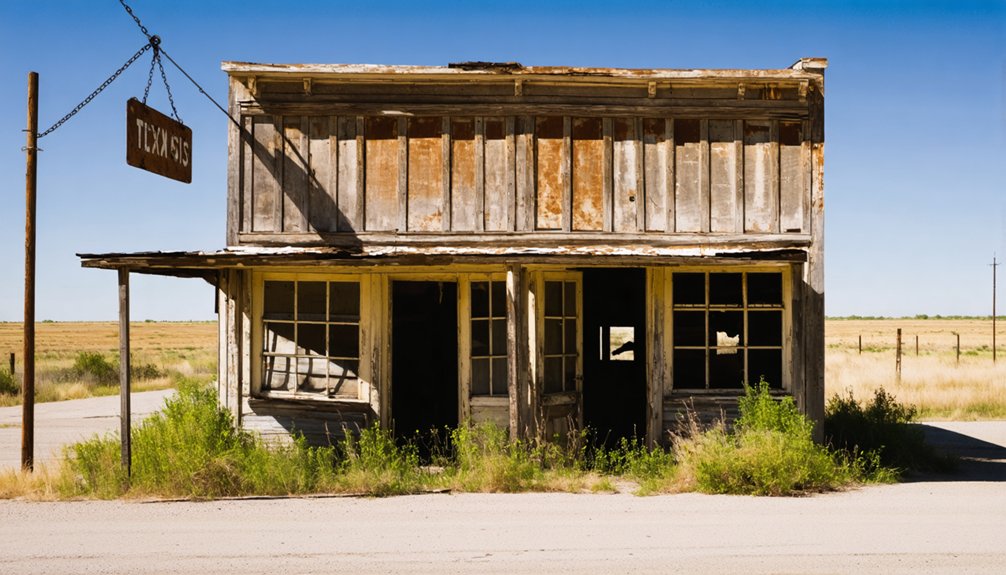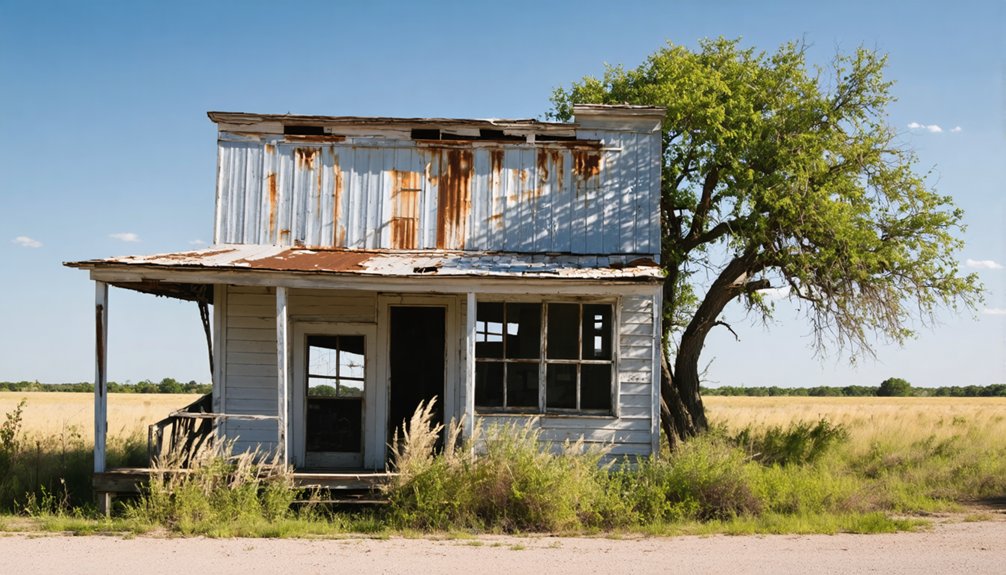You’ll find Plata’s remnants in Texas’ Deaf Smith County, where it briefly served as the county seat in 1890. Originally called Grenada, this frontier settlement emerged in 1883 when Robert Reed Ellison drove 3,000 cattle to Alamito Creek. Despite its promising start with a courthouse, general store, and school, the town faced devastating challenges from harsh winters and the Pecos and Northern Texas Railway’s bypass in 1899. Plata’s dramatic rise and fall captures the untamed spirit of Texas’ frontier era.
Key Takeaways
- Plata was established in 1883 when Robert Reed Ellison drove 3,000 cattle to Alamito Creek in Texas.
- Originally named Grenada, the town was renamed La Plata in 1890 to resolve postal confusion with similarly named settlements.
- The town’s decline began when the Pecos and Northern Texas Railway bypassed it in 1899.
- A devastating blizzard in 1897 killed massive numbers of livestock, causing half the population to abandon the settlement.
- By 1898, all buildings were relocated to Hereford, the new county seat, leaving Plata to become a ghost town.
The Birth of a Frontier Settlement
When young Robert Reed Ellison drove 3,000 cattle to Alamito Creek in March 1883, he laid the foundation for what would become the frontier settlement of Plata. At just sixteen years old, he’d transported the herd by train to Murphysville before driving them the final forty miles to his father’s ranch, marking the beginning of Plata’s ranching origins.
You’ll find Plata’s strategic location along Farm Road 169 near Alamito Creek proved ideal for cattle operations. The arrival of the Atchison, Topeka and Santa Fe Railway transformed this remote spot into a crucial transportation hub, sparking early community development. In late 1930, the area gained additional significance when it was designated a station by the Kansas City, Mexico and Orient Railway. Similar to the town of Ayr, Plata faced significant challenges when the railroad bypassed the settlement.
Ellison later established his own substantial ranch here, while other settlers followed, drawn by the promise of open range and railway access. The settlement grew to include essential amenities like a general store and eventually a school.
From Grenada to La Plata: A Name’s Evolution
The frontier settlement first took root under a different name – Grenada. As you’d explore this early Texas Panhandle community, you’d discover that its name significance stems from an interesting postal conflict that shaped its identity.
Early settlers called their Texas Panhandle town Grenada, until postal confusion sparked a change that would shape its destiny.
When postal officials realized there was already a Grenada in Texas, they requested a change to prevent mail delivery confusion.
On December 1, 1890, the town officially became La Plata when court proceedings opened under the new name. The XIT Ranch, a powerful force in the region’s development, had helped establish the settlement and its operations. By 1898, all buildings were moved to the new county seat of Hereford. Interestingly, in Argentina, La Plata would also undergo a name change when it was temporarily renamed Ciudad Eva Perón in 1952.
This name change marked a pivotal moment in the town’s history, though it wouldn’t be the last major transformation you’d see in this frontier community.
Political Battles and County Seat Wars
You’ll find La Plata’s most dramatic moment in October 1890, when it secured the county seat through a highly suspicious 97-7 election that required Texas Rangers to maintain order.
Originally known as Grenada, the town’s name change occurred when postal officials requested the modification to avoid confusion.
The small frame courthouse was constructed from lumber transported from Amarillo.
The victory proved short-lived when, in 1899, the Pecos and Northern Texas Railway bypassed the town entirely, dealing a devastating economic blow to La Plata’s future.
After losing both its railway prospects and a second county seat election that same year, La Plata watched as its courthouse and jail were dismantled and moved to the new seat of Blue Water (later Hereford).
Corrupt County Seat Election
Political tensions erupted in Deaf Smith County during the heated county seat election between La Plata and Ayr, marked by widespread corruption and intense rivalry.
You’d find election fraud rampant throughout the process, as competing factions fought desperately for control over taxation, commerce, and development priorities in the region. Political manipulation took many forms – from outright vote-buying to strategic settlement patterns designed to influence voter turnout. The town’s original name of Grenada was changed to La Plata shortly after the controversial election.
The XIT Ranch, wielding substantial influence over local governance, played a pivotal role in these power struggles. They’d established La Plata (originally Grenada) specifically to consolidate their political control after Deaf Smith County’s formation in 1890.
The disputed election outcomes reflected the high stakes involved, as whoever controlled the county seat effectively directed the region’s future development and economic destiny. The conflict ultimately ended when the county seat was moved to Hereford in 1898, marking a significant shift in local power dynamics.
Fatal Railroad Decision
Beyond the contentious county seat election, railroad politics struck a fatal blow to La Plata’s future.
You’ll find that political battles in the Texas Legislature during the 1880s created infrastructure challenges that would shape the town’s destiny. When lawmakers repealed land grant laws and imposed stricter railroad regulations in 1882, construction southward from Taylor ground to a halt. The Gould ownership era brought additional instability to Texas railroad development during this period.
While other Texas towns secured essential rail connections through political maneuvering and local demands, Plata wouldn’t see tracks until 1930 when the Kansas City, Mexico and Orient Railway finally arrived. Similar to the yellow fever epidemic that devastated railroad construction crews in other Texas towns in 1887, these setbacks severely impacted development in the region.
By then, it was too late. The decades without rail access had already sealed Plata’s fate, limiting its growth to a small ranching community while other rail-connected towns flourished.
This critical delay in railroad development proved decisive in Plata’s ultimate decline.
Daily Life in Early La Plata
Life in early La Plata centered around the county courthouse, which served as the heart of the community’s social and judicial activities. You’d find yourself attending Saturday night dances followed by Sunday church services in the same building.
The courthouse wasn’t just for legal matters – it housed community gatherings and early education before dedicated structures were built.
If you were raising children in La Plata, they’d join about 65 other students at the local school, including some who traveled from New Mexico. Your daily routine might include visits to the general store, pharmacy, or blacksmith shop.
While ranching dominated the economy, you’d face the challenges of drought years and harsh winters. The local newspaper, La Plata Star, kept you informed of regional happenings and official announcements.
Nature’s Wrath: Environmental Challenges

Despite its promising start as a county seat, La Plata’s fate was sealed by a relentless series of environmental catastrophes that began almost immediately after its 1890 founding.
You’d have witnessed the town’s drought resilience tested severely from 1891-1894, as crops withered and livestock suffered without reliable water sources. The lack of irrigation infrastructure left settlers completely dependent on increasingly scarce rainfall.
The parched earth offered no mercy, leaving settlers and their herds at nature’s whim as water grew scarce.
The devastating blizzard impact of 1897 delivered the final blow to this struggling community. With temperatures below freezing for three straight weeks, you’d have seen massive livestock deaths and watched as half the population abandoned their homes.
The harsh reality of settling this high plains location, chosen more for political expediency than environmental suitability, ultimately proved too challenging for La Plata’s survival.
The Railroad Decision That Changed Everything
You’ll find Plata’s initial promise as a ranching community was deeply tied to its 1930 designation as a Kansas City, Mexico and Orient Railway station, complete with a water tank and railroad siding.
The railroad’s strategic placement about four miles south of Alamito provided vital transportation access for local ranching products and helped sustain Plata’s store and school through the mid-20th century.
When rail service eventually declined, Plata’s essential transportation lifeline was severed, leading to the closure of its school and store by the late 1980s and accelerating the community’s descent into ghost town status.
Railroad Location Proves Fatal
The 1899 construction of the Pecos and Northern Texas Railway marked the beginning of La Plata’s end when railroad officials strategically bypassed the town in favor of Blue Water (later renamed Hereford).
The railroad’s impact on settlement patterns proved swift and devastating, as the lack of rail access stripped La Plata of its economic lifeline.
You’ll find these harsh realities shaped La Plata’s rapid decline:
- Businesses and residents quickly relocated to rail-served towns
- Local commerce collapsed without essential connections to regional markets
- Farmers and ranchers couldn’t efficiently transport their goods
- The county seat shifted to Blue Water, taking the courthouse and jail with it
La Plata’s fate was sealed, and by the early 1900s, the once-promising town had virtually disappeared from the Texas landscape.
Town’s Transportation Lifeline Lost
Following the fateful bypass of La Plata, similar patterns of railroad-driven decline emerged in Plata during the early 20th century.
You’d have witnessed Plata’s initial promise when it became a station on the Kansas City, Mexico and Orient Railway in 1930, linking the town’s ranching operations to essential markets.
Without reliable rail access, you’re looking at a town that couldn’t sustain its economic lifeline. The transportation challenges hit hard – cattle shipments grew costly and inefficient, forcing ranchers to rely on slow wagon transport over poorly maintained roads.
You’ll find that Farm Road 169 couldn’t match the railroad’s capacity for moving livestock and supplies. The economic decline was inevitable – as the rail service diminished, so did Plata’s chances of attracting new residents and businesses.
Remnants and Relics of a Lost Town

Modern-day visitors seeking physical evidence of Plata’s existence will find their search particularly challenging, as this ghost town‘s remnants have largely vanished from both the Texas landscape and historical record.
Plata has become a true ghost of Texas history, its physical traces erased from both the land and written records.
Unlike well-documented Texas ghost towns such as Terlingua or Indianola, Plata’s abandoned structures have left minimal traces.
You’ll encounter a stark absence of:
- Standing ruins or foundations typically found at preserved ghost towns
- Historical markers or interpretive signs documenting the town’s story
- Ghostly remnants of civic buildings like churches, schools, or commercial sites
- Accessible artifacts or structural remains for explorers to photograph
The site stands in sharp contrast to places like Toyah or Lobo, where physical evidence still tells the story of Texas’ frontier past.
Plata’s vanishing act represents one of the state’s most complete disappearances.
La Plata’s Legacy in Texas History
Although La Plata’s physical structures have vanished from Texas soil, its historical significance echoes through Deaf Smith County’s development as a pioneering settlement that shaped the region’s early growth.
You’ll find La Plata’s cultural heritage preserved in the Texas Historical Marker that now stands where this ambitious town once thrived under XIT Ranch’s influence.
The town’s complex community dynamics played out in its fierce county seat battle with Ayr, while its role as an essential stop on the New Mexico-Amarillo Road showcased its strategic importance.
Despite facing brutal environmental challenges, including the devastating 1897 blizzard and severe droughts, La Plata’s brief existence left an indelible mark on Texas history, demonstrating the resilience and determination of early frontier settlements.
Frequently Asked Questions
What Was the Total Population of La Plata at Its Peak?
While the winds of time have scattered exact population trends, historical demographics suggest you’d likely have found between 200-300 souls at La Plata’s peak before the harsh 1897 blizzard changed everything.
Are There Any Living Descendants of Original La Plata Settlers?
You’ll find it challenging to verify living descendants today, though some family connections may exist among regional ranching families in Deaf Smith County. Descendant stories remain largely undocumented in historical records.
What Happened to the Original La Plata Star Newspaper Archives?
You won’t find the original La Plata Star archives today – newspaper preservation faced major archival challenges when the town’s buildings were dismantled in 1899. No surviving copies are documented in public collections.
How Much Did Land and Properties Cost in La Plata?
Like tumbleweed crossing barren plains, La Plata’s land prices and property values remain largely unknown. You’ll find specific costs undocumented, though nearby ghost towns suggest prices around $10,000 per acre in comparable sales.
Were There Any Notable Crimes or Lawlessness During La Plata’s Existence?
You won’t find much crime history in La Plata beyond political corruption during the county seat election. Despite having law enforcement and a jail, there’s no record of significant lawlessness or violent incidents.
References
- https://en.wikipedia.org/wiki/La_Plata
- https://mix941kmxj.com/see-how-two-texas-ghost-towns-battled-for-the-county-and-lost/
- https://www.allacrosstexas.com/texas-ghost-town.php?city=Plata
- https://newstalk940.com/see-how-two-texas-ghost-towns-battled-for-the-county-and-lost/
- https://www.ghosttowns.com/states/tx/laplata.html
- https://www.hmdb.org/m.asp?m=155119
- https://en.wikipedia.org/wiki/List_of_ghost_towns_in_Texas
- https://www.texasescapes.com/TexasGhostTowns/PlataTexas/PlataTexas.htm
- https://www.tshaonline.org/handbook/entries/la-plata-tx
- https://www.tshaonline.org/handbook/entries/plata-tx



